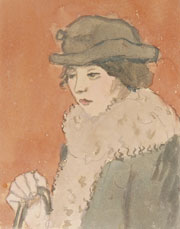Reading researcher solves Princeton painting mystery
Release Date 13 December 2011

Early 20th century painter Gwen John has been named as the artist behind a 50 year old collection of unsigned paintings at Princeton University in America.
Professor Anna Gruetzner Robins, from the Department of Art, has identified two albums containing 23 watercolours as the work of John, now recognised as one of the most important painters of her generation.
The albums are in the extensive papers of the British poet and critic Arthur Symons (1865-1945), and have been preserved in Princeton University's Library since 1951.
Professor Robins, a world authority on modern British painting, came across the watercolours by chance while researching at Princeton and immediately recognised them as the work of John. Both John and Symons were natives of Pembrokeshire, Wales, but they met for the first time in Paris. Symons's letters to John revealed that John gave the albums to Symons in June 1920 shortly after his return from France.
Professor Robins said: "Symons and John belonged to interconnecting networks that brought artists, writers, actors, gallery owners and collectors together in the increasingly international world of Paris, London and New York. The discovery of the two Symons albums makes a considerable contribution to an understanding of her greatness."
Gwen John (1876-1939) was the sister of British artist Augustus John (1878-1961) and the one-time lover and model of French sculptor Auguste Rodin (1840-1917). Made during her productive years, beginning in 1917, many of the watercolours depict nuns, women parishioners and orphaned girls in the Catholic church at Meudon, the Paris suburb where John lived for nearly 30 years. Almost all of these subjects are viewed from the back.
Other watercolours in the album portray a woman in a train carriage, a woman wearing a striking boa and a black cat in a window. A few of the watercolours have pencil sketches on the reverse.
The American painter and art collector A.E. Gallatin (1881-1952) acquired the papers and albums from Symons' widow and donated them to the Princeton University Library in 1951. The albums are preserved in the Library's Manuscripts Division in Department of Rare Books and Special Collections.
In an article recently published in the Princeton University Library Chronicle, Professor Robins shows the relationship of the Princeton albums to two albums once belonging to the New York attorney and art collector John Quinn (1870-1924) and to works in British institutions.
Ends
For all University of Reading media enquiries please contact James Barr, Press Officer tel. 0118 378 7115 or email j.w.barr@reading.ac.uk
Notes for Editors:
Images: Please credit images courtesy of the Princeton University Library, from the originals in the Arthur Symons Papers, Manuscripts Division, Department of Rare Books and Special Collections."
Images to be referred to as Album 2:2 and Album 2:5
The University of Reading's Department of Art comprises the former long established departments of Fine Art and History of Art. It has a shared history with its origins in the Reading School of Art, established in 1860 the founding school of the present University.
It has developed a distinctive approach to Art through a combination of practice, theory and history. All of the academic staff are actively engaged as artists, researchers, historians and curators. Its special strengths lie in exhibition history and curatorial practice, in artists' writing and in theoretical and historical approaches to art.
Art at Reading has illustrious alumni from artists Walter Sickert and Terry Frost to Turner Prize nominees Mike Nelson, Cornelia Parker and Richard Wilson.
Princeton University is a world-renowned research university that stands in the nation's service and in the service of all nations. Chartered in 1746, Princeton is the fourth-oldest college in the United States and is located in Princeton, New Jersey. The university is an independent, coeducational, nondenominational institution that provides undergraduate and graduate instruction in the humanities, social sciences, natural sciences and engineering.
Today, more than 1,100 faculty members instruct approximately 5,100 undergraduate students and 2,580 graduate students. The ratio of undergraduate students to faculty members is 6 to 1. The University's generous financial aid program ensures that talented students from all economic backgrounds can afford a Princeton education.
